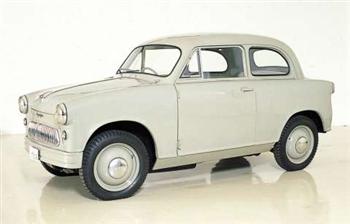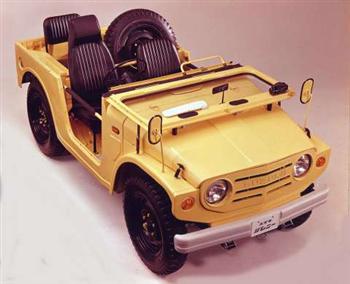|
Home | News | Road Tests | ||||||||||||||||||||||||
100 Years of Suzuki Excellence
In its 100 year history, Suzuki has developed an outstanding reputation for manufacturing a range of cars, 4WDs, motor cycles and marine products offering excellent value for money and exceptional reliability. Continually striving to improve the breed through competition motor sport, Suzuki has racked up a string of world titles on two and four wheels and is now one of the 10 largest automotive manufacturers on the planet. However, like most great companies, Suzuki’s genesis was humble in both size and operation. In 1909, Michio Suzuki founded the Suzuki Loom Company in the small sea coast village of Hamamatsu, Japan. Business boomed as Suzuki built weaving looms for Japan's giant silk industry. Suzuki's only desire was to build better, more user-friendly looms and, for the first 30 years of the company's existence, its focus was on the development and production of these exceptionally complex machines. Despite the success of his looms, Michio realised his company had to diversify and he began to look at other products. Based on consumer demand, he decided that building a small car would be the most practical new venture. The project began in 1937, and within two years Suzuki had completed several compact prototype cars. These first Suzuki motor vehicles were powered by a then-innovative, liquid-cooled, four-stroke, four cylinder engine. It featured a cast aluminium crankcase and gearbox and generated 13 horsepower from a displacement of less than 800 cc. With the onset of World War II, production plans for Suzuki's new vehicles were halted when the government declared civilian passenger cars a "non-essential commodity." After the war, Suzuki went back to its roots. Loom production was given a boost when the US government approved the shipping of cotton to Japan and Suzuki's fortunes brightened as orders began to increase from domestic textile manufacturers. But the joy was short-lived as the cotton market collapsed in 1951. A motor corporation commences Faced with this challenge, Michio’s thoughts returned to motor vehicles. After the war, the Japanese had a great need for affordable, reliable personal transportation, with a number of firms offering ‘clip-on’ gas-powered engines that could be attached to a bicycle. Suzuki's first two-wheel effort came in the form of a motorised bicycle called the Power Free. Designed to be inexpensive and simple to build and maintain, the 1952 Power Free featured a 36 cc two-stroke engine and an ingenious double sprocket gear system. An unprecedented feature for its time, the gear system enabled the rider to either pedal with the engine assisting, pedal without engine assist, or simply disconnect the pedals and run on engine power alone. The system was so inspired that the patent office of the new Japanese democratic government granted Suzuki a financial subsidy to continue research in motor cycle engineering. And so commenced the Suzuki Motor Corporation. In 1953, Suzuki scored the first of countless racing victories when the tiny 60 cc Diamond Free won its class in the Mount Fuji Hill Climb.
By 1954, Suzuki was producing 6,000 motor cycles per month and had officially changed its name to Suzuki Motor Co., Ltd. Following the success of its first motor cycles, Michio designed an even more successful automobile – the 1955 Suzulight – which showcased the company’s penchant for innovation from the beginning. The Suzulight included front-wheel drive, four-wheel independent suspension and rack-and-pinion steering – features now common on cars produced half a century later. In 1957, Michio stepped down after nearly 50 years at the helm, handing over the reigns to son-in-law Shunzo who adopted his wife’s surname. Michio continued to have an active role in the day-to-day running of his company, staying on as Shunzo’s adviser. Two-wheeled success Over the next decade Suzuki continued to develop its motor cycle range and looked to expand its reach throughout the world. Australia was one of the first countries to import Suzukis, with a batch of 125 cc Suzuki Colleda motor cycles arriving in January, 1960. With new levels of value and reliability, the fast-growing range of motor cycles quickly became popular with Australian customers. Most notable were Suzuki's two-stroke vertical twins. In 1966, the X6 Hustler became Suzuki's first true street-legal performance machine, and the fastest Japanese 250 cc of its time. It was followed by the Cobra, the world’s first 500 cc two-stroke motor cycle, which developed with the more 'masculine' styling of the Titan that became one of the most popular motor cycles on the road here in the early 1970s.
The company also continued its motor cycle racing efforts, developing its engineering skills and learning everything it could. By 1962, Suzuki was in Europe winning the first ever 50 cc Grand Prix World Championship. A year later, Suzuki won the title again, as well as the 50 cc class at the legendary Isle of Man TT. Suzuki also began competing and winning off-road. In the World Motocross Championships, long dominated by European makes, Suzuki won the 1971 500 cc title; a trophy it would gain four more times, in 1972, '73, '75 and '76. Suzuki extended its MX success with an incredible string of victories in the 125 cc World Championship, winning the title from 1975 to 1984. In 1973, Shunzo became chairman of SMC, with Jitsujiro Suzuki assuming the mantle of president. Back on the road, Suzuki's two stroke range grew to include a series of in-line triples, capped off by the GT750 - the largest mass-production liquid-cooled two-stroke street bike ever offered to the public. Suzuki's road racing efforts expanded to the premier 500 cc class, with British rider Barry Sheene winning successive World Championships onboard the exotic RG500 square four. This enduring race bike would go on to two more title wins in 1981 and 1982 with Italians Marco Lucchinelli and Franco Uncini riding. But with tightening emissions standards, four-stroke in-line fours would lead Suzuki's charge starting in 1976 with the new GS750, boasting a relatively short stroke, double overhead cams, twin disc brakes and fine handling. The GS1000 that soon followed is judged by critics as arguably the best one-litre four-cylinder of its time. The GS worked well on the track, too, with Wes Cooley piloting a Yoshimura-tuned GS1000 to Suzuki’s first AMA Superbike Championship in 1979. He followed up with another win in 1980, as well as two wins in the world’s premier motor cycle endurance race – the Suzuka Eight Hour. By the early 1980s, Suzuki had firmly staked out its territory as a major player in the market for tough, reliable, high-performance motor cycles.
Bound for a land down under Suzuki began engineering a new breed of vehicle – a compact 4x4 – in 1968. Known as the LJ10, it was powered by a tiny 360 cc two-stroke engine developing just 24 horsepower. In spite of the lack of mechanical power, the combination of a light weight body, compact dimensions and full-time 4x4 gearing made the LJ10 an exceptional performer in tough, off-road conditions. That made the rugged conditions that make up much of Australia an obvious choice for Suzuki as an export market. The first – the LJ20 – made its official Australian debut at the 1974 Melbourne Motor Show. It quickly garnered a legion of fans, with its exceptional value for money and ability to leave bigger, more expensive 4WDs in its wake. It was upgraded in 1978 by the LJ80, now boasting an 800 cc four-cylinder engine. A pick-up version designated LJ81 – known as the Stockman – also made its way to Australia where it became a favourite with farmers around the country. That was the same year Jitsujiro took over as chairman of the company, with Osamu Suzuki promoted to the president’s role. Suzuki Australia P/L (SAPL) was incorporated in 1980, as a motor cycle and marine product distributor, responsible for importing, marketing and selling the growing Suzuki range. In 1988 the company welcomed the arrival of a new breed of vehicle – the compact SUV. Suzuki realised customers were looking for a vehicle that could combine serious off-road performance, but still be customer friendly around town. And so arrived the Vitara. Built on a new platform and boasting more room and power than its Sierra sibling, the Vitara had a ladder frame chassis and dual range gearing, combined with genuine creature comforts. It proved a hit in Australia, and around the world, and was responsible for opening up the outback to a new generation of Australians. In 1994 SAPL began taking over automobile distribution in Victoria and Tasmania, and by 2000 had assumed responsibility for cars in all states except Queensland. Throughout those years the Suzuki range continued to grow, including favourites such as the Swift GTi and the Cappuccino, and perennial favourites such as the Grand Vitara and current Swift. Since 2004, Suzuki has grown exponentially in Australia, to be the fastest growing brand in the country. Sales have increased 200 per cent, with the company on track to record its seventh successive record sales year in 2009. The range now includes the Swift, SX4, Grand Vitara, Jimny Sierra and APV. Global expansion Suzuki's phenomenal growth in recent years has been predicated on its distinctive domestic and international strategies. Domestically, the company owes its success to its high-quality engines, around which it designs a wide variety of vehicles for special or emerging niche markets. Internationally, Suzuki has traditionally targeted developing countries with growing populations, including China, Hungary, Indonesia and Pakistan, while India is now one of the 'jewels' in the Suzuki 'crown'. A subsidiary of Suzuki Motor Corporation, Maruti Suzuki is India’s largest passenger car company and has led that market for more than two decades. In 2008, more than half of the more than one million cars sold in India – one of the world’s fastest growing economies – wore a Maruti Suzuki badge. The company boasts a sales network of 562 outlets in 372 towns and cities, and more than 2,500 service facilities in over 1,200 towns and cities. Since inception in 1981, Maruti has produced and sold over 6.75 million vehicles, including almost 500,000 units in Europe and other export markets. Rated first in customer satisfaction for eight years in a row in the prestigious J D Power's Surveys, Maruti Suzuki was named India's Most Respected Automobile Company by Businessworld magazine. Maruti Udyog began as a government company, with Suzuki as a minor partner, to make a people's car for middle class India. In 2007, the Indian government sold the last of its stake, forging the start of Maruti Suzuki India Limited, with SMC owning 54 per cent of the new company. Suzuki Goes Off-Shore and All-Terrain In 1977, Suzuki took to the water, forming a new company to market its proven outboard motors in the U.S. By the 1980s, Suzuki was selling a complete line-up of two-stroke motors, ranging from a modest two horsepower model to a mighty 225 horse outboard. Along the way, Suzuki introduced a series of technological breakthroughs, including oil injection, dual-plug heads and Microlink, a computerised control system for optimal engine timing. In 1982, Suzuki took the lead in the hot new market for all-terrain vehicles by introducing the first four-wheel ATV: the top-selling QuadRunner LT125. A full line of Suzuki Quads followed the LT125, and competing manufacturers soon offered their own four-wheeled ATVs. More Racing Success While Suzuki was just starting up the compact SUV craze, its motorcycles had already carved an enviable reputation at the highest levels of racing. After the initial success of the GS and the subsequent Katana super sport models of the early 1980s, Suzuki originated the mass production repli-racer Superbike in 1986 with its revolutionary GSX-R750. Never before had a bike with so much potential been offered to so many riders. A young Kevin Schwantz won the Daytona 200 miler in 1988, the first of numerous other Superbike races on GSX-Rs enroute to the 500 cc title on board a Suzuki RG500 in 1994. And Suzuki started its longtime ownership of the near-stock AMA 750cc Supersport Series. Since 1996, Suzuki has won every 750 cc SS title, and virtually every race. In 1996, Suzuki unveiled an all-new 750 with a liquid-cooled engine and twin-spar aluminium frame. Lighter than some of its competitors by 20 kg, the new GSX-R ruled Supersport racing. With the help of 'Aussie' Mat Mladin, this GSX-R claimed back-to-back AMA Superbike Championships in 1999 and 2000. In 2001, Mladin and Yoshimura debuted yet another new low-mass GSX-R750 at Daytona, and easily won the event. The year also saw the debut of the outrageous GSX-R1000, featuring class-leading horsepower packed into a ridiculously light frame. Like the 750 before it, the new 1000 dominated bike-of-the-year honours worldwide. While the GSX-Rs collected most of Suzuki's road racing trophies, other notable wins came around the world. Kenny Roberts Jr joined Team Suzuki in 1999 and won a slew of races on his Suzuki V-four before winning his first 500 cc World Championship during the 2000 season. The outstanding success of the GSX-R series culminated in 1999 with the launch of the Hayabusa GSX-R 1300. With a top speed of more than 300 km/h, the ‘Busa has already garnished a reputation as the world’s quickest superbike. Off the pavement, Suzuki saw increasing success as well. In the mid-1990s, Suzuki claimed 125 cc AMA East and West Coast Supercross Championships, while South African Greg Albertyn won the AMA 250 cc Outdoor National Championship. Australian-born Chad Reed recently re-signed with Suzuki, and in 2009 will look to repeat his success in the AMA and World Supercross championships. He kicked his campaign off in fine style, and was never headed in any round of the 2008 Australian SX Championships. On four wheels, the Suzuki charge was led by legendary racer Nobuhiro ‘Monster’ Tajima, who earned his place in history with his record-smashing Grand Vitara that took championships at Pikes Peak and Race to the Sky. Tajima was also the driving force behind Suzuki’s entry into full-time rallying, when the Ignis was entered in the 2003 Junior World Rally Championship. Super Swede Per-Gunnar Andersson piloted the car to the 2004 driver and manufacturer’s title and repeated the dose with a runaway win driving a Swift Sport in the 2007 series. The Suzuki Tradition Continues In June 2000 Osamu Suzuki, who had served as president of Suzuki Motor since June 1978, became chairman and CEO of the company. The longtime leader, who had married a granddaughter of the company founder and took his wife's family name, had built Suzuki into a global powerhouse through his consistent focus on small cars, cost-containment, and conservative fiscal practices, while maintaining an aggressive approach to expanding into developing markets. What was once a small group of dedicated engineers, designing the world's finest weaving machinery, has today grown into a worldwide company of almost 50,000 people, who make and distribute products in more than 190 nations. Worldwide, Suzuki sells more than two million vehicles a year, surpassing the sales of such renowned marques as BMW, Mercedes and Mazda. Suzuki motor cycles are the first choice of more than 2 million riders every year. As it enters its 100th year, Suzuki will continue its tradition of technological trailblazing, and appealing to customers who demand unique design, value, reliability and superior engineering. More Suzuki News .....
here | ||||||||||||||||||||||||
|
About | Car Clubs | Home | News | Road Ramblings | Road Tests | Subscribe | Top Drive © 2009 All rights reserved. Next Car Pty. Ltd. |





